The Best Float Fishing Rigs For Steelhead
UPDATED 03 NOVEMBER 2023
by Robert Ceran
Float fishing is one of the best ways to catch steelhead, as it is ideally suited for drift fishing.
And since the majority of steelhead are caught in rivers, float fishing is ideal for targeting them.
However, in order to catch steelhead successfully with float fishing rigs, it’s essential to know which rigs perform best under what conditions, as well as the right technique you should use for fishing them.
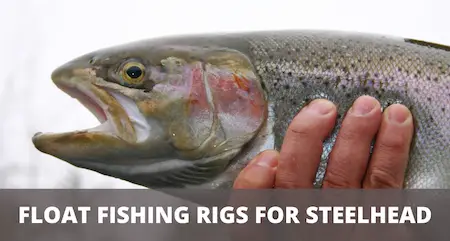
In this article we’ll walk you through the most important float fishing rigs for steelhead, explaining how to tie them, and what purposes each of them is ideally suited for.
How do you rig up for steelhead float fishing?
The 3 best steelhead float rigs are:
- Fixed float rig
- Slip float rig
- Bobber doggin rig
Each of these rigs comes with its own strengths and weaknesses, which means you need to choose the right one based on the conditions you’re going to be fishing in.
This is easiest to achieve if you know the basics about each rig, and what each of them is ideally suited for.
Now let’s cover each of these rigs in full detail, and discuss their pros and cons, so you can choose the best one for your purposes.
Fixed float rig for steelhead
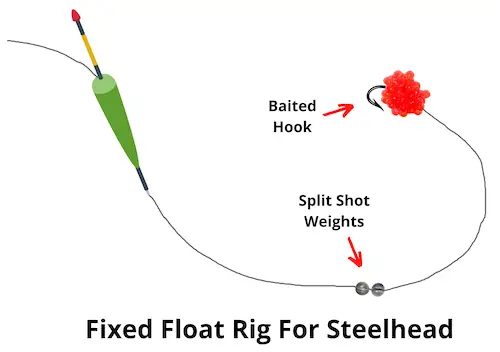
This is by far the simplest float fishing rig for steelhead, and works best for shallow water fishing.
How to tie it: If you’re using monofilament as your main line, you can thread the fixed float onto your main line, and then tie the main line directly to a size 6 to 10 hook, followed by adjusting the depth between the float and the hook.
Next, add some split shot weights to weigh down your hook in the water, and make the float stand up straight in the water.
However, if you’re using braid as your main line, you should tie a fluorocarbon or monofilament leader underneath the float (as described for the sliding float rig below).
When to use it: This is a great low water steelhead float rig, and works best in situations where the water is less than 5 feet deep.
The reason why you can’t use it for deeper water is because you’re limited by the length of your rod. Also, keep in mind that the deeper you set the float, the harder it becomes to cast the rig without tangling it up.
How to use it: Since this is such an easy rig to set up, it’s a great option for drift fishing for steelhead in shallow rivers and streams.
Also, since you can quickly change the depth of your float, it’s easy to fish several different depths along the same run before moving in.
Slip float rig for steelhead
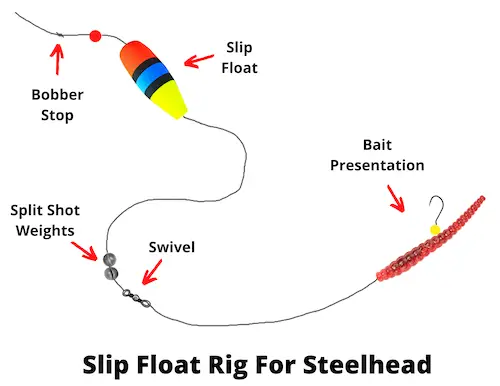
The slip float rig is a little more complicated in terms of its setup, but comes with the advantage that you can reach deeper water with it, which is essential when fishing for steelhead in rivers that are deeper than 5 feet.
How to set it up: Start by tying a bobber stop to your main line, followed by threading a plastic bead and then a slip float onto it. Next, tie the line to a swivel, and add several split shot weights between the float and the swivel.
The bead above the float prevents it from getting stuck on the bobber stop, while the split shot weight below the float prevents it from getting stuck on the swivel. Finally, tie a 2 to 4 foot long fluoro or mono leader to the swivel with your baited hook at its end.
When to use it: This is the best all around float rig for steelhead, as you can use it to fish for steelhead in a wide range of water depths, from 2 feet to 20 feet.
It’s best to use this rig for drift fishing in 6 to 12 feet deep water.
How to use it: When using the sliding float rig for steelhead, it’s important to drift your baited hook just above the bottom (ideally within 1 foot of the bottom).
When you use it to drift along a new stretch of river, start by setting it a little too shallow.
Then gradually increase the depth until you notice the float leaning downstream with the current, which indicates that your rig is being dragged along the bottom.
Another great thing about this rig is that it’s a great salmon bobber setup, and you can even target both species at the same time using a slip bobber rig.
Bobber doggin rig for steelhead
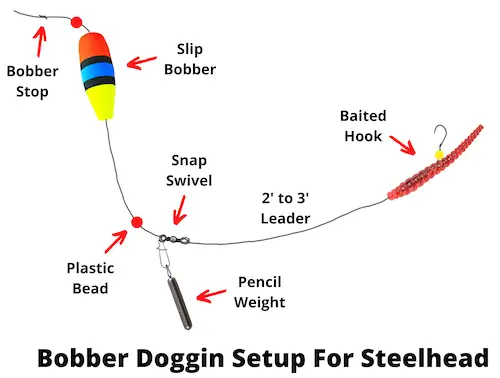
The bobber doggin rig is one of the most effective steelhead rigs out there, and combines several key advantages of bottom drift fishing rigs with float fishing rigs.
How to tie it: The bobber doggin setup is a little more complex than that of the other float rigs, but is well worth the effort when the conditions are right for using it.
The top part of the setup is very similar to the slip float rig described above, but underneath the slip float thread on a plastic bead instead of a split shot.
Next tie your main line to the eye of a snap swivel with the snap on it (as shown in the image above), and then attach a pencil weight to the snap.
Finally, tie a 1 to 2 feet long leader (either mono or fluoro) to the other eye of the snap swivel, and then tie your baited hook to the leader.
When to use it: This is a great rig to use for steelhead drift fishing, and is extremely effective both from a boat or from the bank.
This rig is designed to drag your bait presentation right across the bottom of the river, which is the ideal strike zone for steelhead.
The float is pulled downstream by the current, and this in turn drags the pencil weight and your baited hook across the bottom.
How to use it: Start by setting the depth of your sliding float to about 1.5 times the estimated depth of the river.
This is important because you actually want the pencil weight to be dragged along the bottom, and so you want to see your float leaning downstream with the current as it drags the weight.
If you see the float standing up straight in the water, that means the float is set to shallow, and you need to increase the depth.
Bobber doggin vs float fishing – which is better for steelhead?
There can be no doubt that bobber doggin is by far one of the most effective techniques for catching steelhead, which explains why it has become so popular among steelhead anglers in recent years.
The bobber doggin setup has 3 key advantages:
- It presents your bait right on top of the bottom.
- The float helps avoid getting your weight snagged all the time.
- The float is an effective bite indicator.
As you can see, these advantages combine the strengths of a classical drift fishing rig with bobber fishing for steelhead, and this killer combination makes it so effective for catching steelhead.
However, if you’re a beginner, it’s probably best to start with a float fishing rig, since that is easier to set up and easier to fish with.
Also, a regular float fishing setup is designed not to drag your weight and hook across the bottom of the river, which is the best way to avoid getting snagged.
Then, once you have a little more experience, you may want to graduate to a bobber dogging steelhead setup.
How to rig a float and jig for steelhead
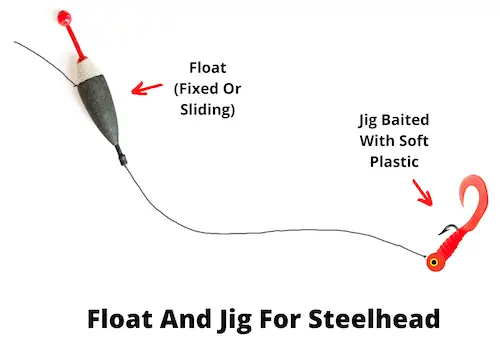
A great way to target steelhead is with a float and jig setup, and you can do this with either a fixed float, or with a sliding float.
By far the easiest way is shown in the image above, where a fixed float is attached to the main line, which is then tied directly to a jig head baited with a soft plastic worm or grub tail.
This setup is possible if you’re using monofilament as your main line, as you don’t need to tie a leader. However, if you’re using braid, you’ll need to tie a fluorocarbon or monofilament leader underneath the float.
The fixed float and jig rig is ideal for fishing in shallow rivers under 5 feet, but if you’re going to fish in deeper rivers, you’ll need to use the slip float rig instead.
The great thing about this setup is that you can easily change the plastic worm on your jig head, so you can test out a range of different colors and sizes.
What size floats are best for steelhead?
The best float size for steelhead depends on the speed of the current and the depth you want to fish at as follows:
- Fast current (or deep water): 6 to 10 gram floats
- Slow current (or shallow water): 4 to 6 gram floats
Keep in mind that the bigger your float is, the more split shot weights you’ll need to weigh down your hook and to make the float stand up straight in the water. This is helpful if you’re fishing in a strong current, or if you want to get your bait down to the strike zone as fast as possible.
However, when you’re fishing in shallow water (especially in very clear water), keep in mind that a big float and big weights are more likely to spook the fish. That’s why a smaller float with fewer split shots is often a better choice on smaller rivers and when fishing shallow runs.
What shot patterns should you use for float fishing steelhead?
The best shot pattern for float fishing steelhead depends on the speed of the river current as follows:
- Fast current: Bunch up all split shots close to the leader (ideally right above the swivel between the main line and the leader), to weigh down your hook and get it down into the strike zone fast enough.
- Medium speed current: Space out your split shots in regular intervals along the line between the float and the leader swivel, with the smallest split shots close to the bottom.
- Slow current: Bunch up all split shots right underneath the float, to avoid spooking fish with split shots that are close to your hook.
Another factor that affects split shot patterns is water clarity. In very clear water the steelhead can readily see your split shot weights, so you’ll want to keep them as far away as possible from your hook, while still being able to get it down into the strike zone.
What is the best line for steelhead float fishing?
The best main line for steelhead float fishing is either monofilament or braided line. Mono has the advantage that you can use it without a leader if you’re using 8 to 12 lb test monofilament.
However, braid has the advantage that it floats better on the water than mono, which makes it better for managing your line while drift fishing with floats.
It’s important to keep the line between your float and the rod tip off the water as much as possible when drift fishing for steelhead, to prevent the float moving unnaturally due to line drag. This is called mending the line, and is easier to accomplish with braid than with either mono or fluoro.
If you decide to use braid as your main line (20 to 50 lb test is a good strength to use), you’ll need to tie a leader in order not to spook the fish, and 8 to 12 lb test fluorocarbon is ideal for this.
How long should a leader be for steelhead float fishing?
The best leader length for steelhead float fishing is 2 to 3 feet. If you’re fishing in stained water you can go down to 1 foot, and in gin clear water you may want to increase leader length to 4 feet. Essentially, the leader length is proportional to how well steelhead are able to see your swivel and weights.
Another factor that plays into this is the speed of the current – the faster the current, the less time steelhead will have to check out your swivel and weights before they decide to commit to eating your bait.
Because of this, you can use a shorter leader in strong current, though the best all around length is definitely between 2 and 3 feet.
Final remarks
This concludes our article on the best float fishing rigs for steelhead. Remember not to overthink it, and get out there and start testing.
Experience always trumps theory, and that applies to steelhead fishing as much as anything else.
